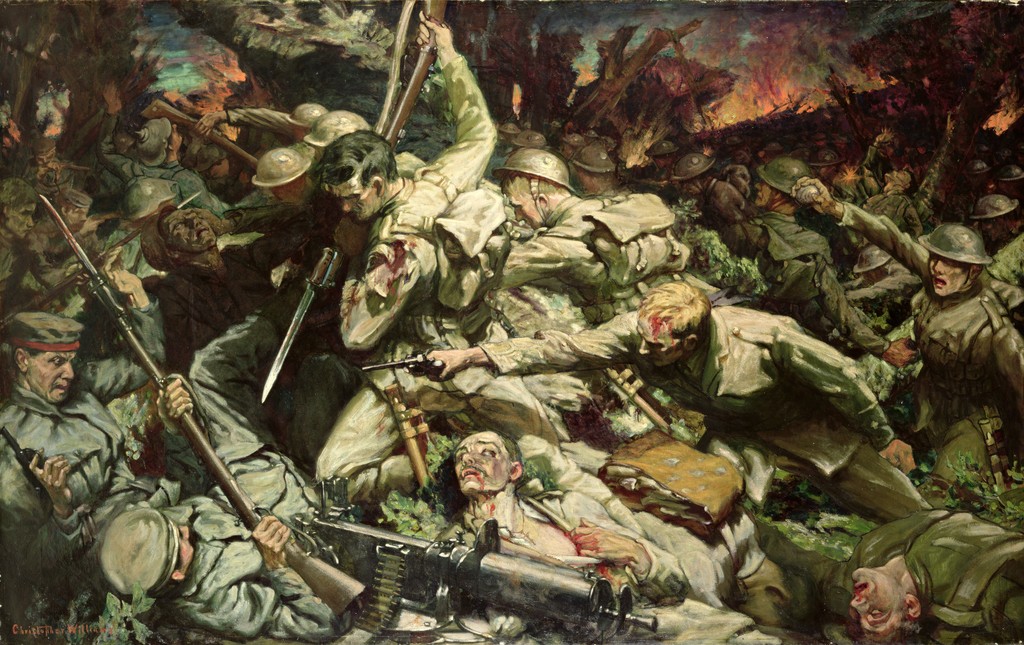 |
| Mametz Wood, by Christopher Williams |
The poem draws on a tradition of poems about this WW1 battle--Sheers visited the site when researching the poet David Jones (wounded at Mametz Wood), whose 'In Parenthesis' is one of the greatest long poems of this or any war (for more about 'In Parenthesis' look at Tim Kendall's War poetry blog, which has a really interesting discussion about Jones, and his connection to Sassoon).
The poem that really resonates here for me, though, is Robert Graves, 'A Dead Boche'. Graves also fought at Mametz wood, and his memory of the battle is a gruesome one, from the aftermath:
 A Dead Boche
A Dead Boche
To you who’d read my songs of War
And only hear of blood and fame,
I’ll say (you’ve heard it said before)
”War’s Hell!” and if you doubt the same,
Today I found in Mametz Wood
A certain cure for lust of blood:
Where, propped against a shattered trunk,
In a great mess of things unclean,
Sat a dead Boche; he scowled and stunk
With clothes and face a sodden green,
Big-bellied, spectacled, crop-haired,
Dribbling black blood from nose and beard.
And only hear of blood and fame,
I’ll say (you’ve heard it said before)
”War’s Hell!” and if you doubt the same,
Today I found in Mametz Wood
A certain cure for lust of blood:
Where, propped against a shattered trunk,
In a great mess of things unclean,
Sat a dead Boche; he scowled and stunk
With clothes and face a sodden green,
Big-bellied, spectacled, crop-haired,
Dribbling black blood from nose and beard.
The description Graves presents here is so very far away from the clean 'china plate...bird's egg' imagery of Sheers, it seems to me almost like Sheers is creating a deliberate contrast, and one which accentuates the time that has passed since the battle. his final image, of the singing skeletons, brings a touch of joy and almost healing humour to the grim image of the mass grave.
The picture that he presents throughout the poem, of farmers unearthing pieces of bodies as they plough, is made tender by the semantic field that he uses. Not only do you have the naturalness of 'tended...bird's egg...nested' (with connotations of boys searching for bird's eggs? a common occupation at the time of WW1), but also the sheer ordinariness of the 'china plate'. There's a contrast within the poem, of language which is positive, even life-enhancing with that which destroys, so that you can almost feel the vulnerability of the broken skull within the image of the men 'told to walk, not run /towards the wood and its nesting machine guns'. In this line, for instance, the enjambement creates a little pause before 'towards the wood' which echoes the preceding pause of 'walk, not run', creating a sense of movement and hesitancy, and the association of 'wood' and 'nesting' seems to have us back in the semantic field of birds for a moment before the awful realisation of 'machine guns' at the end of the line. It's interesting that this line also gives us one of the two rhymes in the poem, the other coming at the end, the couplet 'run/guns'.
The personfication of the earth which 'stands sentinel' creates an extended metaphor of the wounded land 'reaching back into itself', a phrase which echoes the first line where the farmers have 'tended the land back into itself'. This sense of retrospection, of thinking back and feeling the past as a vivid reality is made clearer by the image of 'a wound working a foreign body to the surface of the skin'. The phrase is also, of course, a rather dark-edged pun, or play on words--since the poet is talking literally about bodies which are foreign to the land. We might think here about Rupert Brooke's famous sonnet starting: 'If I should die think only this of me /That there's some corner of a foreign field/That is forever England'. Sheers is perhaps thinking of a similar image.
 The description of the mass grave as 'a broken mosaic of bone' continues this tendency to see the dead as something archaeological (it might be more usually Roman remains one might turn up with a plough), and makes them appear something like an artefact (an idea reinforcd by Sheer's own comment 'whoever had buried them had taken the time to actually link their arms'). The image suggested is also one of the traditional late-medieval danse macabre where a dancing skeleton or skeletons, drawing in people from all walks of life, represented how death could strike at the unwary, even in a time of celebration (see left). For a slightly more cheery version of the idea, see the animation below!
The description of the mass grave as 'a broken mosaic of bone' continues this tendency to see the dead as something archaeological (it might be more usually Roman remains one might turn up with a plough), and makes them appear something like an artefact (an idea reinforcd by Sheer's own comment 'whoever had buried them had taken the time to actually link their arms'). The image suggested is also one of the traditional late-medieval danse macabre where a dancing skeleton or skeletons, drawing in people from all walks of life, represented how death could strike at the unwary, even in a time of celebration (see left). For a slightly more cheery version of the idea, see the animation below!If you'd like to read more about Sheers and his composition of the poem, look at the poetry archive site where you can also hear him reading the poem.
No comments:
Post a Comment